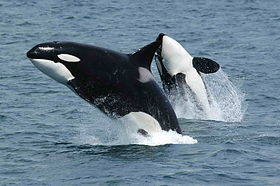
The Temperate Northern Pacific is a biogeographic region of the Earth's seas, comprising the temperate waters of the northern Pacific Ocean.
The Temperate Northern Pacific connects, via the Bering Sea, to the Arctic marine realm, which includes the polar waters of the Arctic Sea. To the south, it transitions to the tropical marine realms of the Pacific, including the Tropical Eastern Pacific along the Pacific coast of the Americas, the Eastern Indo-Pacific in the central Pacific Ocean, and the Central Indo-Pacific of the western Pacific basin. The Taiwan Strait forms the boundary between the Temperate Northern Pacific and the Central Indo-Pacific.
Characteristic fauna include the Pacific salmon and trout (Oncorhynchus spp.), gray whale (Eschrichtius robustus), and North Pacific right whale (Eubalaena japonica).
Subdivisions[edit]
The Temperate Northern Pacific is further subdivided into marine provinces, and the marine provinces divided into marine ecoregions:
Cold Temperate Northwest Pacific[edit]
Warm Temperate Northwest Pacific[edit]
Cold Temperate Northeast Pacific[edit]
- Aleutian Islands
- Gulf of Alaska
- North American Pacific Fjordland
- Puget Trough/Georgia Basin
- Oregon, Washington, Vancouver Coast and Shelf
- Northern California
Warm Temperate Northeast Pacific[edit]
References[edit]
- Spalding, Mark D., Helen E. Fox, Gerald R. Allen, Nick Davidson et al. "Marine Ecoregions of the World: A Bioregionalization of Coastal and Shelf Areas". Bioscience Vol. 57 No. 7, July/August 2007, pp. 573–583. [1]
Well, that’s interesting to know that Psilotum nudum are known as whisk ferns. Psilotum nudum is the commoner species of the two. While the P. flaccidum is a rare species and is found in the tropical islands. Both the species are usually epiphytic in habit and grow upon tree ferns. These species may also be terrestrial and grow in humus or in the crevices of the rocks.
View the detailed Guide of Psilotum nudum: Detailed Study Of Psilotum Nudum (Whisk Fern), Classification, Anatomy, Reproduction